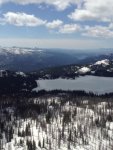wolftalonID
Very Active Member
I am a commercially rated helicopter pilot with my CFI rating, which means I can teach flying.
Pilots are held accountable to Department of Transportation rules for operations of their aircraft. The actual business being conducted determines to what extent the rules restrict the pilot.
For this discusion, most flights would fall under FAA rules FAR part 91.119 FAR( Federal Aviation Regulations )
read as follows.
Except when necessary for takeoff or landing, no person may operate an aircraft below the following altitudes:
(a) Anywhere. An altitude allowing, if a power unit fails, an emergency landing without undue hazard to persons or property on the surface.
(b) Over congested areas. Over any congested area of a city, town, or settlement, or over any open air assembly of persons, an altitude of 1,000 feet above the highest obstacle within a horizontal radius of 2,000 feet of the aircraft.
(c) Over other than congested areas. An altitude of 500 feet above the surface, except over open water or sparsely populated areas. In those cases, the aircraft may not be operated closer than 500 feet to any person, vessel, vehicle, or structure.
(d) Helicopters, powered parachutes, and weight-shift-control aircraft. If the operation is conducted without hazard to persons or property on the surface—
(1) A helicopter may be operated at less than the minimums prescribed in paragraph (b) or (c) of this section, provided each person operating the helicopter complies with any routes or altitudes specifically prescribed for helicopters by the FAA; and
(2) A powered parachute or weight-shift-control aircraft may be operated at less than the minimums prescribed in paragraph (c) of this section.
The thing that TopGun posted was an exerpt not from the FAR but from a suppliment called the AIM ( Areonautical Information Manual )
the AIM section is a helpful tool to further explain certain rules and general practices. Its reference was noted by the three numbers spaced apart.
That section is a reference to areas of natural preservation where they dont like nature to be disturbed. Wildlife refuges, Grand Canyon sections, etc. its not a rule but a guideline for altitudes to help assist preservation.
The rule in part 91 is law.
In an emergency, the pilot in command can diviate from any part of the law in efforts to save the ship, crew and passengers. Spotting a big ol bull however doesnt fall under that exception.
so....
long explanation aside.... Get a helicopter pilot to fly you in lower than 500 ft if its in your budget. I personally love flying over my hunting area....just not during season.
Pilots are held accountable to Department of Transportation rules for operations of their aircraft. The actual business being conducted determines to what extent the rules restrict the pilot.
For this discusion, most flights would fall under FAA rules FAR part 91.119 FAR( Federal Aviation Regulations )
read as follows.
Except when necessary for takeoff or landing, no person may operate an aircraft below the following altitudes:
(a) Anywhere. An altitude allowing, if a power unit fails, an emergency landing without undue hazard to persons or property on the surface.
(b) Over congested areas. Over any congested area of a city, town, or settlement, or over any open air assembly of persons, an altitude of 1,000 feet above the highest obstacle within a horizontal radius of 2,000 feet of the aircraft.
(c) Over other than congested areas. An altitude of 500 feet above the surface, except over open water or sparsely populated areas. In those cases, the aircraft may not be operated closer than 500 feet to any person, vessel, vehicle, or structure.
(d) Helicopters, powered parachutes, and weight-shift-control aircraft. If the operation is conducted without hazard to persons or property on the surface—
(1) A helicopter may be operated at less than the minimums prescribed in paragraph (b) or (c) of this section, provided each person operating the helicopter complies with any routes or altitudes specifically prescribed for helicopters by the FAA; and
(2) A powered parachute or weight-shift-control aircraft may be operated at less than the minimums prescribed in paragraph (c) of this section.
The thing that TopGun posted was an exerpt not from the FAR but from a suppliment called the AIM ( Areonautical Information Manual )
the AIM section is a helpful tool to further explain certain rules and general practices. Its reference was noted by the three numbers spaced apart.
That section is a reference to areas of natural preservation where they dont like nature to be disturbed. Wildlife refuges, Grand Canyon sections, etc. its not a rule but a guideline for altitudes to help assist preservation.
The rule in part 91 is law.
In an emergency, the pilot in command can diviate from any part of the law in efforts to save the ship, crew and passengers. Spotting a big ol bull however doesnt fall under that exception.
so....
long explanation aside.... Get a helicopter pilot to fly you in lower than 500 ft if its in your budget. I personally love flying over my hunting area....just not during season.



